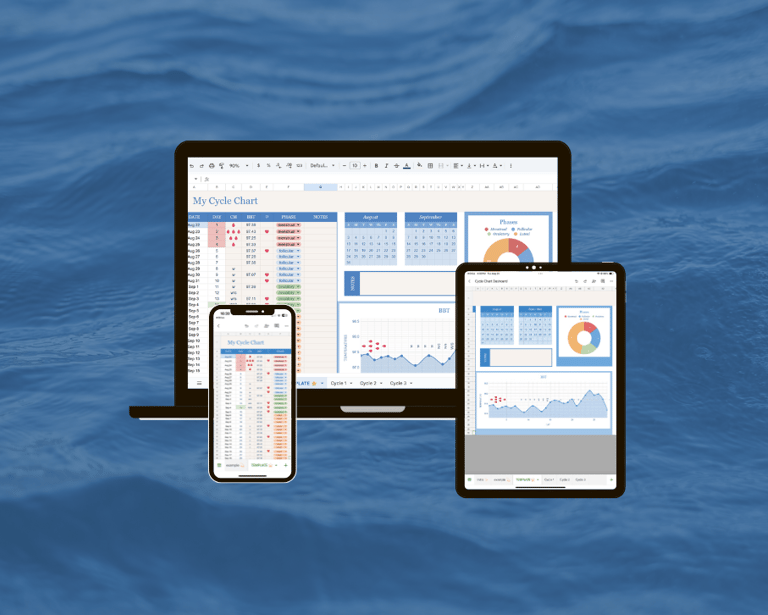
10 Key Bio-Markers: How to Know You're Ready for Conception After Loss
You need more than a prenatal. Learn the 10 signs to look for—from digestion to BBT—to build a rich, fertile foundation and find confidence in your next pregnancy journey.
Caroline Bomer
10/28/20255 min read


When you're preparing to conceive, especially conceiving again after loss, the desire to feel absolutely confident in your body’s readiness is overwhelming. You want to know, deep down, that you are giving yourself and your future baby the best possible foundation for a healthy pregnancy.
Unfortunately, most of us are only given two inadequate pieces of advice: just take a prenatal and just give it time. The truth is, feeling lost and afraid is not a strategy. We can do better.
If a baby is the seed, then your body is the soil. In gardening, we know that planting a seed in fertile, rich ground will bring healthier plants and a more abundant harvest. It's the same thing with your body and conception. You need to know what to look for and how to create that lush, fertile health.
Fertility is about more than your uterus and your ovaries- it's a whole-body event. We know this, and yet we overlook the health of our digestion, thyroid, metabolism, strength, and the countless health markers beyond our reproductive system. And honestly, we skip over most of those markers too. If you do end up doing testing & blood work, it's often a couple thyroid labs and hormone levels. For one, these are often done inaccurately, and two, they're incomplete. In other words, the data you gain from these tests don't hold much weight and point you in the wrong direction.
Thankfully, there are plenty of markers you can watch for in your everyday life. Your body will tell you when it's ready to conceive, if you know how to listen.
1. Menstrual Cycle: Between 24-36 days ideally, the closer to 28 the better. The length only varies by a couple days at most from cycle to cycle. It's predictable and symptom-free.
2. Period: Between 3-7 days long, and again, only varies slightly from cycle to cycle. It's bright red, with a clear start and stop (little to no spotting). Clotting should be minimal, almost not noticeable. A healthy flow is about 40mL, or 2-3 tablespoons overall.
3. Ovulation: If you're not ovulating, there is no chance for pregnancy because no egg is released. You can confirm ovulation by tracking your Basal Body Temperature (BBT). You can still have a period even if you're not ovulating. Irregular cycles or missing periods are a tell-tale sign of either infrequent or skipping ovulation.
4. Basal Body Temperature: This is your internal temperature, checked with an oral thermometer when you first wake up in the morning before you move around much. "Basal" just means it goes to two decimal places, like 97.34 instead of 97.3, for example. It should be at least 97 degrees Fahrenheit, or 36.11 degrees Celsius, and significantly higher after ovulation. A healthy baseline BBT is a sign your thyroid is healthy and that your body is utilizing & producing energy well.
5. Cervical Mucus: While it changes throughout your cycle, a lack of cervical mucus- especially the slippery, wet, stretchy kind- is a key indicator that your hormones and/or minerals may be off. This fertile cervical mucus nourishes sperm, keeping it alive for days and facilitates it moving up to the fallopian tubes where it will meet an egg.
6. Luteal Phase Length: This is the phase between ovulation and your period. It should be the longest phase, ideally at least 10 if not 12 days long. Any shorter than that and it means you're not producing enough progesterone, which is key for conception and maintaining pregnancy throughout the first 8-12 weeks of pregnancy until the placenta can take over.
7. Digestion: Bloating, gas, IBS, etc. indicate your gut health needs major support. A good sign of healthy digestion is having regular bowel movements 1-3x a day that are well-formed and easy to pass. Sluggish digestion means your body is struggling to absorb nutrients, your microbiome isn't healthy, and your hormones aren't being used or eliminated properly, contributing to further imbalance.
8. Energy: If you're lacking energy to make it through the day yourself- hitting that mid-day crash and fighting brain fog- then it's no wonder your cycle and fertility are sub-par. This can point to under-eating, being depleted in certain nutrients, blood sugar imbalances, a sluggish thyroid, or over-exerting yourself in ways that don't serve you. Are you really overwhelmed, or does your body just not have the resources it needs to function at its best?
9. Hair & Nails: Thick, healthy, strong hair and nails are a fantastic sign of health. The opposite indicates certain nutritional deficiencies. For example, breakage is often a lack of protein, while white spots on your nails are a sign of low zinc, which is critical for progesterone production.
10. Libido: If your desire for sex and intimacy is low or non-existent, that's one of the key fertility red flags. (The caveat would be if your low libido is rooted in trauma or abuse, which is an entirely other thing.) This is protective. If your body is struggling to keep you alive and healthy, lowering your desire to expend even more resources on creating life is actually a smart move. It's totally normal for your desire and arousal to fluctuate throughout your cycle, but you should feel an enhanced libido around ovulation in particular. It's literally your body's signal and desire to get pregnant.
Preparing to conceive, especially after loss, is no small feat mentally or physically, but I am confident that every woman can feel peace and assurance in her body and decisions when she has the right tools and information. Even if you do "all the things," it doesn't guarantee that you'll prevent every challenge. The point isn't to prevent problems, but to give yourself the best chance possible. If you do face complications or loss, you'll be more physically and emotionally resilient, have a much easier recovery, and have full confidence knowing you did everything you could for you and your growing family.
For women who have experienced loss, these 10 indicators aren't just data points; they are keys to restoring trust in a body that may feel like it let you down. But I know looking at this list can feel overwhelming when you’re not sure where your body needs to start. This is the piece that generic advice misses. What you need is not more information, but clarity and personalized direction to move from fear and anxiety to confidence and certainty.
I created the Loss Recovery Roadmap because generic advice on the internet can only take you so far. What you really need is a personalized plan designed for the unique demands of conception after loss. In this session, we will deep-dive into your history, symptoms, and lifestyle to cut through the noise and identify your most critical gaps. You'll walk away with a custom plan to address the top 3 things holding you back from healing—complete with custom recommendations for nutrition, cycle charting, and lifestyle shifts—so you can stop guessing and finally find the peace of mind you deserve.
This is why I've loved using my Cycle Charting Cheat Sheet. For the last 2 years (when I haven't been pregnant), it's been an amazing tool as I practiced being more mindful of my body, my fertility, and my hormonal health. There's space to record cervical mucus patterns, BBT, sex, cycle phase, and record daily notes about my mood, libido, or other random symptoms that pop up. It automatically charts your temperature and counts the number of days you spend in each phase, making it easy to check on your Luteal phase length each cycle.


